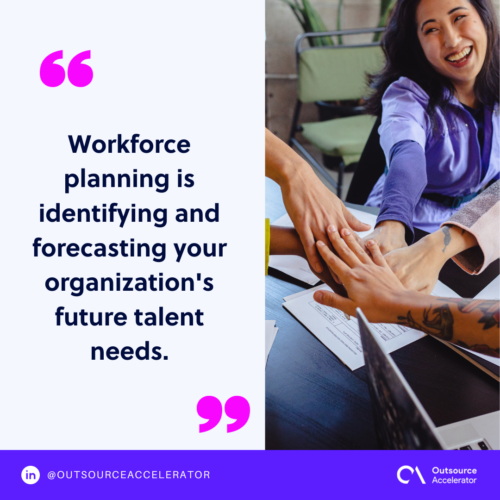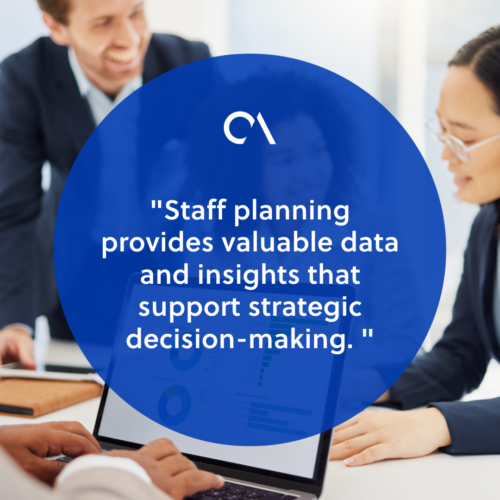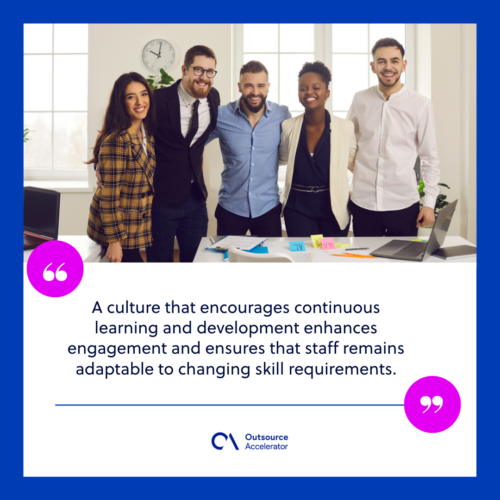8 benefits of workforce planning

Are you a business owner or a manager looking to ensure the success and growth of your organization?
If so, workforce planning should be at the top of your priority list.
By effectively managing your workforce and anticipating future needs, you can position your company for long-term success.
Forbes noted how important workforce planning is by highlighting how difficult it is for most employers to forecast future workload demand.
According to a Forbes piece, a good way to do it is by seeing talent as human capital. Predicting workforce needs is easier if the talents are visible in each function, department, and division.
Let’s further explore the benefits of workforce planning, what it entails, and the steps to implement it successfully.
What is workforce planning?
Workforce planning is identifying and forecasting your organization’s future talent needs. It calls for implementing strategies to acquire, develop, and retain top talent.
It also involves aligning your people strategy with your business objectives. This ensures you have the right people in the right roles at the right time.
Labor force planning uses several indicators to gauge how suitable and effective a company’s current staff is. Some of the most common workforce planning metrics are:
- Age, race, and gender diversity ratio
- Headcount
- Contract type and distribution
- Full-time employees
- Internal mobility rate
- Employee retention rate

8 benefits of workforce planning
Effective workforce planning is crucial for several reasons. Let’s explore the eight key benefits it provides:
1. Avoid talent shortages and surpluses
Workforce planning acts as a guardian against the pitfalls of understaffing and overstaffing. It allows you to anticipate your organization’s future talent needs.
To paint a clearer picture, it lets you avoid situations where you have too few employees to meet demand or an excess of staff with no clear roles.
Accurately forecasting your employment needs ensures productivity and avoids unnecessary hiring or layoffs.
2. Identify and address skill gaps
Planning your workforce lets you assess your company’s current skills and competencies and compare them to those required to achieve business objectives.
You can then proactively implement training and development initiatives to bridge skill gaps.
3. Manage costs efficiently
A Deloitte report revealed that strategic workforce planning can help a company save up to $6 million for every 100 employees.
While this process demands an initial investment, the long-term cost savings are substantial. Reactive hiring and layoffs can incur significant financial risks.
By aligning staffing levels with business needs, staff planning helps organizations:
- Optimize their budget
- Minimize unnecessary expenses
- Allocate resources more efficiently
4. Increase employee engagement and retention
Planning your labor force can uncover opportunities to enhance employee engagement and retention.
Employers can create a positive work environment that increases job satisfaction and reduces turnover by:
- Providing clear career development plans
- Offering training and growth opportunities
- Ensuring competitive compensation packages
5. Support strategic decision-making
Staff planning provides valuable data and insights that support strategic decision-making.
Understanding your firm’s current and future manpower needs allows you to make informed choices about:
- Organizational restructuring
- Expansion plans
- Resource allocation
This ensures your business remains agile, competitive, and poised for growth.

6. Improve recruitment and selection
Attracting and retaining top-notch professionals in a competitive talent landscape is a perpetual challenge. Workforce planning, however, transforms this challenge into an opportunity.
Identifying skill gaps early on so you can tailor recruitment efforts and invest in targeted training programs.
7. Strategic skill development
In an era where skill requirements evolve at an unprecedented pace, labor force planning becomes a catalyst for strategic skill development.
By anticipating future skill needs, organizations can proactively invest in training initiatives. It ensures staff remain equipped to meet the demands of evolving job roles.
This strategic foresight not only bolsters the workforce but also positions the company as an industry leader.
8. Have agility in adapting to change
Change is inevitable, but not all organizations possess the agility to navigate it seamlessly. Being able to plan for your workforce needs acts as a cornerstone for adaptability.
Businesses with effective workforce planning can pivot swiftly, whether it’s responding to:
- Market shifts
- Technological advancements
- Unforeseen challenges
Workforce planning steps
Implementing a workforce plan requires a systematic approach:
- Analyze your current workforce. Assess your organization’s current workforce composition, skills, and capabilities.
- Forecast future talent needs. Consider your long-term business objectives and predict the type and quantity of talent needed to achieve them.
- Identify skill gaps. Identify and compare the skills and competencies critical for success with your current workforce’s capabilities.
- Develop strategies. Come up with strategies to bridge the skill gaps, including recruitment, training, and development initiatives.
- Implement and evaluate. Put your workforce plan into action and regularly evaluate its effectiveness. Make adjustments as needed to ensure ongoing alignment with your company’s goals.
Workforce planning best practices
Ensure the success of your workforce planning efforts with the following best practices:
- Involve stakeholders. Engage key stakeholders in the planning process. Their input and insights will contribute to more accurate forecasting and better decision-making.
- Leverage data and technology. Use workforce analytics tools and HR software to gather and analyze data.
- Continuously review and update. Regularly review and update your workforce plan to reflect changes in your business environment, industry trends, and internal talent needs.
- Foster a culture of continuous learning. A culture that encourages continuous learning and development enhances engagement and ensures that staff remains adaptable to changing skill requirements.

In essence, workforce planning is the strategic roadmap that empowers organizations to navigate the complexities of talent management.
By unlocking its many benefits, businesses can survive and thrive in the modern workplace.







 Independent
Independent




